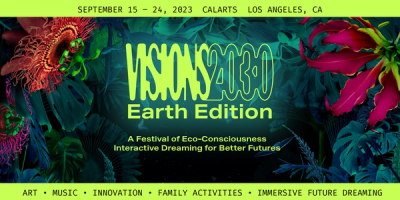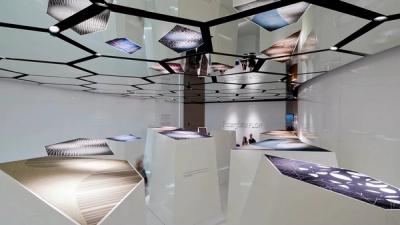
How do we dream forward, as a society?
We hold aspirations for ourselves — but can we collaborate on visions for our world with others? And in doing so, might we push things in unbelievably positive directions?
At 2020Visions, we are developing techniques to provide a space to dream — and dream together — to arrive at unexpected solutions. To go to the very source of inspiration, to fuse ideas, to wield power. We call this Collective Dreaming.
In this moment of pandemic, politics, and panic, it’s all too easy to yell at the television or doom-scroll through news of racial injustice and looming climate disasters. But if you believe that what you hold in your consciousness is what you attract (a hippie-dippie notion, I realize), this may have the opposite of the desired effect. What might be more productive is to contemplate the direction in which, in an optimal world, we might move.

Photographer Unknown.
2020Visions is devoted to living in the solution.
In this, the imagination is a vital tool. It not only creates great artworks and diverts us with fantasies, but it is also responsible for inventions, aspects of scientific theories, social constructs that shape our world. Imagination is with us all the time — helping us, for example, to make decisions. It can circumvent dead ends. Instead of butting our heads against the wall — we fly over the wall completely.
Our minds shape a mental image of what we want to move toward. Artists, of course, use imagination to give birth to fully formed universes. Some of these have affected us inextricably, even changing the world. (The recent graphic novel and mini-series Watchman, for example, awakened many to the 1921 Tulsa Race Massacre.) Some such universes anticipate futures to come. H. G. Wells’ fantastical turn-of-the-century novels describing aircraft, space travel, nuclear weapons, and satellite television even inspired many future inventions.
And instead of reacting against, we can use creativity to rejuvenate our spirits and dream the direction in which our world might move. Conversely, dwelling on dire circumstances, even in the laudable act of political resistance, is like planning a trip by detailing where you don’t want to go.
So much of how the mind works remains a mystery. However, we know that simply articulating a vision can be very powerful. Athletes use visualization techniques in training to do the impossible. Perhaps it is that envisioning where we want to go motivates, or awakens us to clues we are looking for. Perhaps it gives the unconscious subliminal cues. Or perhaps it is simply that dreams have their own magnetism and weight.
Architect and futurist Buckminster Fuller deployed a “preferred states” exercise, in which a group brainstorms about optimal conditions in a certain arena (e.g., climate, peace, city infrastructure, education). Subsequently, through team-building structures and what Fuller called the World Game, forward-thinking participants compete against one another working through speculative steps to achieve the chosen ideal. Writing here about this envisioning and planning process is our own 2020Visions Collaborations Consultant, Elizabeth Thompson (former director of the Buckminster Fuller Institute).
A similarly forward-thinking tool is scenario planning. 2020Visions Advisor Betty Sue Flowers was integral to Shell International’s scenario-planning technique that it pioneered in the 1970s, directing planners to ask “what if” when they were looking to achieve goals such as limiting global warming or stopping the spread of HIV/AIDS in Africa. Stakeholders are given a variety of possible futures to open minds to possibilities that might seem inconceivable, in order to prepare for them.
Both approaches build roads to “getting there.” Collective Dreaming, however, luxuriates less in logistics, more in the “there” — indeed, in perhaps multiple “theres”: destinations of which nobody has yet conceived or that seemingly defy logic. We spin out details, dip into our psyche to touch wishes beyond consciousness. Sometimes, a mere fragment provides a key. A hidden genius lurks in us all, formulating odd possibilities, conceiving unexpected directions, and offering solutions that circumvent the obvious.

May It Be, Cape Coast, Ghana. Photo: @thedallasexperience
And this visionary house-building can use many hands. Dreaming is normally a solitary experience. Yet, we seek ways to let the dreams we hold affect others and to let theirs shape ours. Can we, in concert, generate something transcendent, letting the ideas of our fellow creatures shatter our own limitations, to weave a joint tapestry? This is territory we are exploring through Collective Dreaming.
And it turns out that merely in articulating and holding hopes, even if not directly sharing, we might affect others. In The Hundredth Monkey Theory, another great dreamer on our team, hacker/filmmaker John Lee, aka John Threat, details an occasion where researchers observed skills inexplicably transmitted from one primate group to another, with no apparent communication. Perhaps a great movement can swell up beneath our feet, simply by holding a powerful viewpoint?
Such brainstorms, constructs, and hopes need not be realistic — in fact, gloriously not. The seemingly fantastical may later prove to be the real. We embrace aspirations’ shifting immateriality—they change as we do. And most of all: fill in the details. In his “I Have a Dream” speech, in defining racial justice, Martin Luther King didn’t speak in abstractions. He spelled out, poetically, what that dream was: that “the nation will rise up and live out the true meaning of its creed” that all persons are created equal. That children “will be judged, not on the color of their skin, but on the content of their character.” These pictures lodge in our souls like a North Star.
Importantly, we do not flee to the positive merely to deny pain. It is vital to acknowledge harsh realities, to feel them through — particularly in these cruel times. And then . . . dream the solution.
Let tragedies, yes, be mourned — but also be an impetus to move forward, spurring novel strategies. Let our imaginations crack things open and offer new pathways. Let us band together and let aspects of others’ dreams affect our own.
And never forget to imagine.

Tiki, Erwan Soyer, collage.
Our First Collective Dreaming Workshop
Just beginning to make forays into this vast and fertile territory, trying out new techniques, and building a theoretical framework, we held our first 2020Visions Collective Dreaming workshop (virtually, of course) on August 15th: a seven-hour session involving nine generous and brilliant participants. Remarkable ideas sprang forth: a dream room, a Mother Earth political party, 3-D printers allowing everyone to design their own clothes.

Maps of the Imagination by Peter Turchi, 2004. Book Jacket design by DJ Stout and Julie Savasky, Pentagram, Austin, TX.
In this maiden journey, the point was to experiment — to reach deep into the psyche to generate, then share ideas. Everyone agreed that this all-day Saturday remote gathering went by surprisingly quickly. Even though its point was not therapeutic, it was experienced as an energizing, often moving, experience. Most strikingly, in this time of branded, marketed, and packaged selves, people felt that the opportunity to think large and let their imaginations roam was unusual and deeply fulfilling. We used exercises to open up imaginations; in break-out sessions, we collaborated on visions.
Future workshops will explore more deeply collective exercises: modeling idea-sharing and dream-fusing, non-verbal and intuitive communication, joint explorations of the unconscious.
A little note on scenarios, by Betty Sue Flowers
Scenarios are stories about the future. What distinguishes them from other types of planning is that they are not forecasts and they are not policy proposals.

The future is always a fiction. We usually create this fiction by projecting the past into the future as a forecast, which increases the plausibility of this story. But holding the future as a single forecast is dangerous because the only thing we know for sure about the future is that it won’t be like the past. (In this pandemic summer, I don’t think I need to expand on this point.)
Preferred States, by Elizabeth Thompson
Among the extraordinary gifts of Buckminster Fuller, legendary inventor of the geodesic dome, World Game, and Dymaxion house, was the capacity to tap into the deep wellsprings of the imagination to bring forth fantastical visions — and then to engage in what he called “design science planning” about how to render those visions in the “real world.”
At the heart of what Fuller called “planetary planning” is the process of defining the “preferred state” of the problem you are trying to solve.

Wangechi Mutu, You Are My Sunshine, 2015.
The Hundredth Monkey Theory: The Power of Noetics by John Lee

Have you ever felt you had an idea that you formed and then later you saw someone else have the same exact idea somewhere else? How could that happen?
The Hundredth Monkey Effect is a hypothetical phenomenon in which a new behavior (or idea) is said to spread by unexplained means from one group to other related groups once a critical number of members of one group exhibit the new behavior (or acknowledge the new idea). — Ron Amundson, 1985
We Mourn Our Collective Dreamers

Photo: Thilipen Rave Kumar
Ruth Bader Ginsberg
“It was not hard to see in her the Brooklynite from an immigrant family who lived out her creed that all people should have ‘equal opportunity to aspire, achieve, participate in, and contribute to society based on their individual talents and capacities.’ That vision led her to make America better and insists that we can too.”
—Justice Goodwin Liu,Washington Post
John Lewis
“You are a light. You are the light. Never let anyone — any person or any force —dampen, dim, or diminish your light. Study the path of others to make your way easier and more abundant. Lean toward the whispers of your own heart, discover the universal truth, and follow its dictates . . . Release the need to hate, to harbor division, and the enticement of revenge. Release all bitterness. Hold only love, only peace in your heart, knowing that the battle of good to overcome evil is already won. Choose confrontation wisely, but when it is your time don't be afraid to stand up, speak up, and speak out against injustice. And if you follow your truth down the road to peace and the affirmation of love, if you shine like a beacon for all to see, then the poetry of all the great dreamers and philosophers is yours to manifest in a nation, a world community, and a Beloved Community that is finally at peace with itself.”
― John Lewis, Across That Bridge: A Vision for Change and the Future of America


























